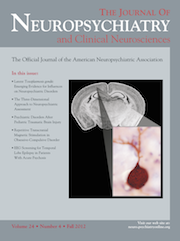A Randomized, Double-Blind Trial of Repetitive Transcranial Magnetic Stimulation in Obsessive-Compulsive Disorder With Three-Month Follow-Up
Abstract
Recent findings indicate that the motor and premotor cortices are hyperexcitable in obsessive-compulsive disorder (OCD). The authors have performed the first randomized, double-blind clinical trial of repetitive transcranial magnetic stimulation (rTMS) in OCD, with a 3-month follow-up. OCD patients (N=22) were assigned to either 2 weeks of active or sham rTMS to the supplementary motor area bilaterally. After 14 weeks, the response rate was 41% (7/12) with active and 10% (1/10) with sham treatment. At 14 weeks, patients receiving active rTMS showed, on average, a 35% reduction on the Y-BOCS, as compared with a 6.2% reduction in those receiving sham treatment.



